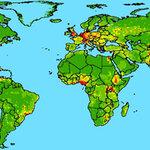Immunology

Researchers from Washington University in St. Louis and the Israeli Institute of Technology (Technion) in Haifa have developed a technique called expected mutual information (EMI)to detect the ancestry of disease genes in hybrid, or mixed, human populations.
EMI determines how a set of DNA markers is likely to show the ancestral origin of locations on each chromosome. The team constructed an algorithm for the technique that selects panels of DNA markers that render the best picture of ancestral origin of disease genes. They then tested the algorithm to show that it is more powerful and…

Scrapie can be transmitted to lambs through milk, according to new research published in BMC Veterinary Research. The study provides important information on the transmission of this prion-associated disease and the control of scrapie in affected flocks. Scrapie is a fatal neurodegenerative disease of sheep and goats.
Clinical signs include itchiness, head tremor, wool loss and skin lesions as well as changes in behaviour and gait.
Timm Konold and colleagues from the Veterinary Laboratories Agency in Weybridge, UK, investigated the transmission of scrapie by feeding milk from scrapie-…

The exchange of genetic material between two closely related strains of the influenza A virus may have caused the 1947 and 1951 human flu epidemics, according to biologists.
The findings could help explain why some strains cause major pandemics and others lead to seasonal epidemics. Until now, it was believed that while reassortment – when human influenza viruses swap genes with influenza viruses that infect birds – causes severe pandemics, such as the ‘Spanish’ flu of 1918, the ‘Asian’ flu of 1957, and the ‘Hong Kong’ flu of 1968, while viral mutation leads to regular influenza epidemics.…

A team of researchers at the University of Alberta, including a scientist at the University of Pennsylvania, have discovered a gene that is able to block HIV, and thought to in turn prevent the onset of AIDS.
Dr. Stephen Barr, a researcher in the Department of Medical Microbiology & Immunology at the U of A, says his team identified a human gene called TRIM22 that can block HIV infection in a cell culture by preventing the assembly of the virus.
Barr says “interestingly, when we prevent cells from turning on TRIM22, the normal interferon response (a natural defense produced by our cells…

Deadly emerging diseases have risen steeply across the world and an international research team has provided the first scientific evidence mapping the outbreaks’ main sources.
They say:
New diseases originating from wild animals in poor nations are the greatest threat to humans and;
Expansion of humans into shrinking pockets of biodiversity and resulting contacts with wildlife are the reason.
Meanwhile, richer nations are nursing other outbreaks, including multidrug-resistant pathogen strains, through overuse of antibiotics, centralized food processing and other technologies.
Zoonotic…

In the work "Tractado contra el mal serpentino" written in 1510 and published in 1539, Ruy Diaz de Isla refers to have cured, during the travel of return in Europe, many members of the shipment of Columbus, affections from certain luetic manifestations and thinks the new disease was imported from Hispaniola (Haiti).
Bartolomè de Las Casas had conceived the same opinion. In the "Historia de Las Indias" he wrote as between the Conquistadores the idea of the "bestiality" of the wild Americans was prevalent and the disease would have been known already previously in the New World.
Moreover the…

A University of Alberta study recommends that workers on pig farms be monitored as part of influenza pandemic preparedness, after a child on a communal farm in Canada was diagnosed with swine flu in 2006.
Though the seven-month-old boy made a full recovery, health researchers were concerned because of evidence that the virus spread to other members of the multi-family community, who, fortunately, all demonstrated mild or no apparent illness. It has been known for a long time that avian and swine strains of flu can spread to humans, with avian strains appearing to be more dangerous than swine…

Malaria is a leading killer in Africa and other developing countries, claiming more than 1 million lives each year, most of them children.
A small clinical trial conducted by an international team of researchers in Mali has found that a candidate malaria vaccine was safe and elicited strong immune responses in the 40 Malian adults who received it.
The trial was the first to test this vaccine candidate, which is designed to block the malaria parasite from entering human blood cells, in a malaria-endemic country. Based on these promising results, the research team is now conducting trials of…

Did Columbus and his men introduce the syphilis pathogen into Renaissance Europe after contracting it during their voyage to the New World? Or does syphilis have a much longer history in the Old World?
The most comprehensive comparative genetic analysis conducted on the family of bacteria (the treponemes) that cause syphilis and related diseases such as yaws, published in PLoS Neglected Tropical Diseases, supports the so-called “Columbian theory” of syphilis’s origins.
Kristin Harper (Emory University, Atlanta, USA) approached this centuries-old debate by using phylogenetics — the study of…

A new influenza virus discovered in Missouri pigs has a combination of genes from avian and swine flu viruses, supporting the theory that pigs can serve as a mixing vessel for flu viruses and a potential source for a human pandemic strain, according to a report published yesterday.
Researchers found that the virus, an H2N3 subtype, caused illness in experimentally infected mice and was transmissible in swine and ferrets, suggesting it has adapted to mammals, according to the report, published in the Proceedings of the National Academy of Sciences (PNAS). In addition, genetic analysis…